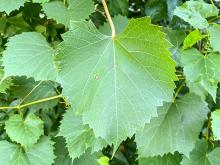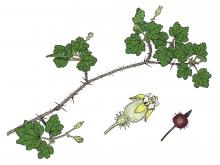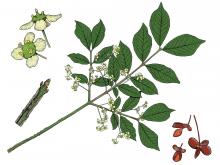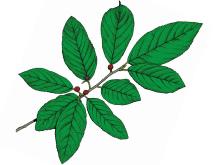Trees, Shrubs and Woody Vines
Media

Species Types
Scientific Name
Vitis species
Description
Eight species of grapes in the genus Vitis are native or naturalized in Missouri. All bear edible fruits. Like their relatives elsewhere, they have important connections to humans and to nature.
Media

Species Types
Scientific Name
Rosa multiflora
Description
Starting more than a century ago, this nonnative rose was planted across America — for many good reasons — but multiflora rose has proven to be invasive, and now the goal is to stop its spread.
Media

Species Types
Scientific Name
Rosa setigera
Description
Also called climbing rose, prairie rose is most common near woodlands, where it climbs and trails on neighboring shrubs and small trees.
Media

Species Types
Scientific Name
Tilia americana
Description
American basswood is a common shade tree planted in lawns, parks, and along city streets. Recognize it by its leaf shape and texture, and by the unusual strap-shaped, reduced leaf attached to the clusters of small flowers.
Media

Species Types
Scientific Name
Ribes cynosbati
Description
Prickly gooseberry occurs mostly in the eastern half of Missouri. Its spine-covered berries turn reddish purple when ripe. Despite the prickles, they are edible.
Media

Species Types
Scientific Name
Vaccinium arboreum
Description
Farkleberry, or sparkleberry, is a stiff-branched shrub or small crooked tree growing in loose thickets on rocky soils, mostly south of the Missouri River. A type of blueberry, its black fruits are edible but dry and mealy.
Media

Species Types
Scientific Name
Euonymus alatus
Description
Burning bush, or winged euonymus, is a nonnative shrub that has been very popular in landscaping for its bright red fall foliage. But it is invasive and spreads aggressively into natural habitats, displacing native species.
Media

Species Types
Scientific Name
Rubus occidentalis
Description
Black raspberries resemble blackberries, but when ripe, the fruits fall away as a caplike unit from the receptacle. Leaflets appear white underneath. The canes are whitish-coated when young; they arch down and take root at the tips. Native and scattered statewide.
Media

Species Types
Scientific Name
Rhamnus caroliniana (syn. Frangula caroliniana)
Description
Carolina buckthorn occurs in the southeastern half of Missouri. It’s a shrub with several main stems, or a small tree potentially reaching 40 feet high, with a trunk diameter of up to 8 inches. Despite the name, there are no thorns.
Media

Species Types
Scientific Name
Aesculus pavia
Description
Red buckeye and Ohio buckeye are both found in Missouri. You can distinguish red buckeye by its having usually 5 leaflets (not 7), its red (not greenish-yellow) flowers, and the absence of any spines on its fruit hulls. Although both buckeyes are cultivated statewide, red buckeye grows in the wild only in our southeastern counties.
See Also
About Trees, Shrubs and Woody Vines in Missouri
There are no sharp dividing lines between trees, shrubs, and woody vines, or even between woody and nonwoody plants. “Wood” is a type of tissue made of cellulose and lignin that many plants develop as they mature — whether they are “woody” or not. Trees are woody plants over 13 feet tall with a single trunk. Shrubs are less than 13 feet tall, with multiple stems. Vines require support or else sprawl over the ground.





















